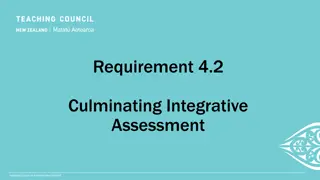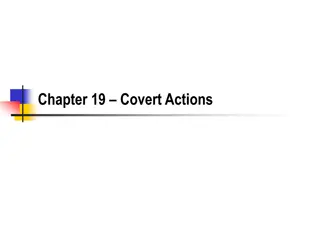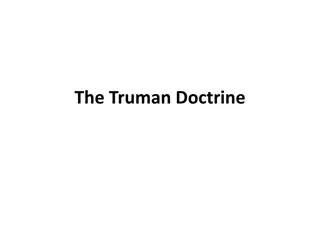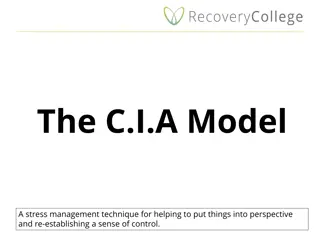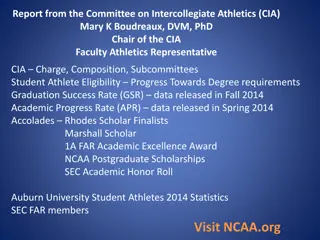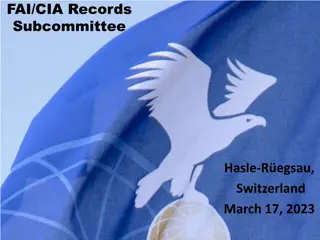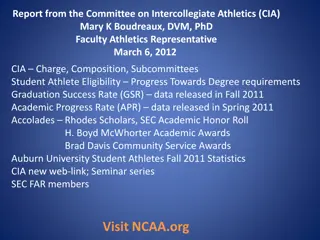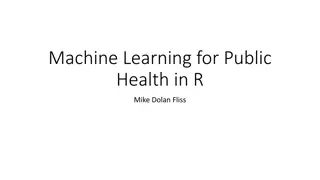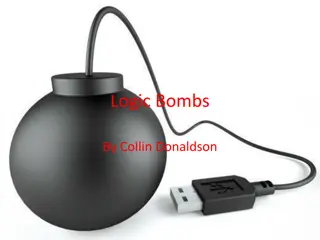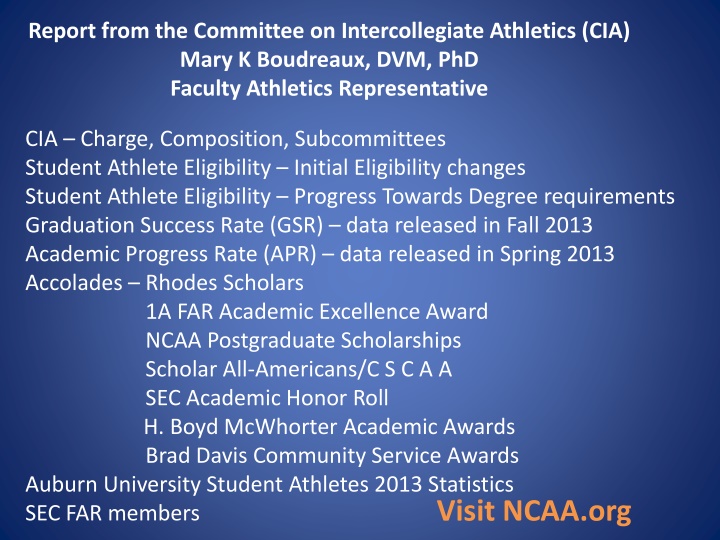
Intercollegiate Athletics Committee Report at Auburn University
"Explore the comprehensive report from the Committee on Intercollegiate Athletics (CIA) at Auburn University, covering topics such as student athlete eligibility, progress towards degree requirements, academic accolades, committee's charge, composition, subcommittees, and more. Get insights into the vital work and initiatives of this influential committee."
Download Presentation

Please find below an Image/Link to download the presentation.
The content on the website is provided AS IS for your information and personal use only. It may not be sold, licensed, or shared on other websites without obtaining consent from the author. If you encounter any issues during the download, it is possible that the publisher has removed the file from their server.
You are allowed to download the files provided on this website for personal or commercial use, subject to the condition that they are used lawfully. All files are the property of their respective owners.
The content on the website is provided AS IS for your information and personal use only. It may not be sold, licensed, or shared on other websites without obtaining consent from the author.
E N D
Presentation Transcript
Report from the Committee on Intercollegiate Athletics (CIA) Mary K Boudreaux, DVM, PhD Faculty Athletics Representative CIA Charge, Composition, Subcommittees Student Athlete Eligibility Initial Eligibility changes Student Athlete Eligibility Progress Towards Degree requirements Graduation Success Rate (GSR) data released in Fall 2013 Academic Progress Rate (APR) data released in Spring 2013 Accolades Rhodes Scholars 1A FAR Academic Excellence Award NCAA Postgraduate Scholarships Scholar All-Americans/C S C A A SEC Academic Honor Roll H. Boyd McWhorter Academic Awards Brad Davis Community Service Awards Auburn University Student Athletes 2013 Statistics SEC FAR members Visit NCAA.org
Charge of the Committee on Intercollegiate Athletics The Committee on Intercollegiate Athletics shall: (1) recommend to the President the policies for the operation of the Intercollegiate Athletics program at Auburn University, (2) monitor for the President all aspects of the Intercollegiate Athletics Program at Auburn University for compliance with University policies, and with NCAA and SEC legislation. (3) assist the President and the Director of Athletics on any aspect of the Intercollegiate Athletics Program for which advice or assistance is requested. The Committee on Intercollegiate Athletics shall meet once per quarter and additionally as called by the President of Auburn University.
Composition of the Committee on Intercollegiate Athletics Mary K Boudreaux, Pathobiology, Chair Barbara Struempler, CHS Nutrition and Dietetics Larry Teeter, Forestry & Wildlife Sciences James Barbaree, Biological Sciences Daniel Svyantek, Psychology Ann Beth Presley, CHS Consumer and Design Sciences Brian Connelly, Management-Business Don Large, Executive Vice-President Jon Waggoner, Interim Vice President of Student Affairs C. Wayne Alderman, Dean of Enrollment Management Kevin Robinson, Executive Director of Internal Auditing Bryan Elmore, A & P Chair Jennifer Richardson Holt, Staff Council Chair Harrison Mills, SGA President Ex-Officio Members Jay Gogue, President Timothy Boosinger and Constance Relihan, Office of the Provost Jay Jacobs, Athletics Director Rich McGlynn, Senior Associate Athletics Director
Subcommittees of the Committee on Intercollegiate Athletics Academic Standards Subcommittee Larry Teeter, Chair Awards Subcommittee James Barbaree, Chair Compliance Subcommittee Mary K Boudreaux, Chair Drug Education/Testing Advisory Group Randall Clark, Chair Equity, Welfare, and Sportsmanship James Barbaree, Chair Priority and Seating Subcommittee Larry Teeter, Chair Athletics Department Seminar Series Barbara Struempler, Chair
New NCAA Division I Initial-Eligibility Academic Requirements For college-bound student-athletes enrolling full time at an NCAA Division I college or university on or after August 1, 2016, there are three possible academic outcomes: 1. Full qualifier = competition, athletics aid (scholarship), and practice the first year. 2. Academic redshirt = athletics aid the first year, practice in first regular academic term (semester or quarter). 3. Nonqualifier = no athletics aid, practice or competition the first year.
High School students will need to meet the following requirements to receive athletics aid, practice and compete their first year: 16 core courses in the following areas: 4 years English 3 years math at Algebra I level or higher 2 years natural or physical science (one lab if offered at any high school attended) 1 year additional English, math or natural/physical science 2 years social science 4 years additional from areas above or foreign language, philosophy or comparative religion. Minimum GPA of 2.300 required in those 16 core courses. Graduate from high school.
Core-course progression Must complete 10 core courses before seventh semester of high school (e.g., senior year). Of the 10 core courses completed, seven must be in the area of English, math, or science. These 10 core courses become locked in for the purpose of core-course GPA calculation. A repeat of one of the locked in courses will not be used if taken after the seventh semester begins.
Student Athlete Eligibility 40-60-80 Rule Once in college, student-athletes must make steady progress toward degrees. Student-athletes must complete coursework required for a degree in the following time frame: 40 percent by the end of their second year, 60 percent by the end of their third year, 80 percent by the end of their fourth year. Student-athletes are allowed five years to graduate while receiving athletically related financial aid. All student-athletes must earn a minimum of six hours each term to be eligible the next semester. From NCAA.org
Graduation Success Rate (GSR) The NCAA developed the Division I Graduation Success Rate in response to college and university presidents who wanted graduation data that more accurately reflect the mobility among all college students today. The rate measures graduation rates at Division I institutions and includes student-athletes transferring into the institutions. It differs from the rate mandated by the federal government, which does not count incoming transfer student-athletes and counts student-athletes who transfer out as not having graduated, regardless of whether they actually did. The Graduation Success Rate also allows institutions to exclude from the computation student-athletes who leave their institutions before graduation, so long as they would have been academically eligible to compete had they remained. From NCAA.org
Federal Graduation Rate (FGR) vs. Graduation Success Rate (GSR) FGR assesses only first-time full-time freshmen in a given cohort and only counts them as academic successes if they graduate from their institution of initial enrollment within a six-year period. It makes no accommodation for transfers into or out of an institution. The rate is very limited because it ignores the large number of transfer students in higher education, but it is still the only rate that allows a direct comparison between student-athletes and the general student body. GSR begins with the federal cohort, and adds transfer students, mid-year enrollees, and non-scholarship students (in specified cases) to the sample. Student-athletes who leave an institution while in good academic standing before exhausting athletics eligibility are removed from the cohort of their initial institution. This rate provides a more complete and accurate look at actual student-athlete success by taking into account the full variety of participants in Division I athletics and tracking their academic outcomes. From NCAA.org
Comparison of Graduation-Success Rates and Federal Graduation-Rate Cohorts (2003-2006 Entering Classes) Enrolled (Under Federal Definition) Enrolled as Frosh in January Two-Year College Transfers Four-Year College Transfers Non-Scholarship Athletes (Only at Schools Not Offering Aid) Total Enrolled Allowable Exclusions (Death, Military, Church Mission, etc.) Left Eligible Participants No Longer Sponsored By Institution Total Denominator Federal Rate 82,552 0 0 0 GSR 82,552 2,549 9,604 8,364 0 82,552 11,617 114,686 (+38.9%) 326 427 0 20,949 0 1,609 82,226 91,701 (+11.5%) Both the GSR and FR evaluate a six-year graduation rate (% of students graduating by end of their sixth year or before the 7th Fall) From NCAA.org
Auburn University GSR Historical Trends 2013 = 2003 to 2006 cohort 78 77 77 76 75 75 74 74 2006 2007 2008 2009 2010 2011 2012 2013 M &W Golf = 57%/100% Gymnastics = 90% M & W Basketball = 58%/92% Equestrian = 88% M & W Tennis = 100%/86% Football = 70% Soccer = 86% Volleyball = 60% M & W Tennis = 100%/86% Football = 70% Soccer = 86% Volleyball = 60%
2013 Average GSR Rate (%) of Last 4 Cohorts Division I and SEC Student-Athletes 91 86 84 83 83 82 82 81 79 79 77 75 75 75 74 DIV I UF VAN UA MSU AU UM UT UGA USC UK LSU ARK TEX MIZZ AM
Graduation Success Rate by Sport 2003 2006 cohorts (n = 324) Men s Sports GSR FR Baseball 48 27 Basketball 92 69 Basketball 58 50 C/C Track 70 69 CC/Track 70 54 Equestrian 88 68 Football 70 61 Golf 100 83 Golf 57 80 Gymnastics 90 62 Swimming 74 58 Soccer 86 74 Tennis 100 100 Softball 88 68 Volleyball 60 Women s Sports GSR FR Swimming 88 70 Tennis 86 43 23 Graduation Rates All Students (%) 2003 2006/6 cohorts (FED Rate) Division I (n = 2,963,437) Auburn (n = 15,522) AU Student Athletes (n = 324) Men 61 Men 64 Women 65 Women 70 Women 65 Combined 63 Combined 67 Combined 60 Men 54
Student Athletes Graduation Rates (GSR %) 2003 2006 Division I (n = 82,223) Men Women Combined Auburn (n = 324) Men Women Combined 75 88 81 68 84 75
Academic Progress Rate (APR) While eligibility requirements make the individual student-athlete accountable, the Academic Progress Rate (APR) creates a level of institutional responsibility. The Academic Progress Rate is a Division I metric developed to track the academic achievement of teams each academic term. Each student-athlete receiving athletically related financial aid earns one retention point for staying in school and one eligibility point for being academically eligible. A team s total points are divided by points possible and then multiplied by one thousand to equal the team s APR. From NCAA.org
Academic Progress Rate Calculation Example A Division I Football Bowl Subdivision team awards the full complement of 85 grants-in-aid. If 80 student-athletes remain in school and academically eligible, 3 remain in school but are academically ineligible and 2 drop out academically ineligible, the team earns 163 of 170 possible points for that term. Divide 163 by 170 and multiply by 1,000 - team s APR that term is 959. The NCAA calculates the rate as a rolling, four-year figure that takes into account all the points student-athletes could earn for remaining in school and academically eligible during that period. Teams that do not earn an APR above specific benchmarks face penalties ranging from scholarship reductions to more severe sanctions. Teams that score below 925 and have a student-athlete who both failed academically and left school (0 for 2) can lose scholarships (up to 10 percent of their scholarships each year) under the immediate (contemporaneous) penalty structure. From NCAA.org
The APR penalty structure was significantly revamped in 2011, effective with the 2012-13 academic year. After sitting at a 900 APR for the first five years of the program, the penalty benchmark will slowly increase over the next several years. Teams are required to earn a 900 four-year APR in 2012-13 and 2013-14. The benchmark is raised to 930 for 2014-15 and beyond. From NCAA.org
Penalty Structure for multi-year APR of less than 900/930 Level 1 Practice penalties (4 hours/day/week of practice in season resulting in 16 hours per week rather than 20 and 5 days per week rather than 6, to be replaced with academic activities. Level 2 Adds out of season practice restrictions (4 hours per week), cancellation of nontraditional season or spring football and for sports without a nontraditional season, a 10% reduction in contests and length of season. Level 3 Menu of options including financial penalties, restricted NCAA membership, coaching suspensions for a designated number of contests and/or recruiting, restricted access to practice for incoming student-athletes that fall below predetermined academic standards and multi-year postseason competition bans. Teams will be subject to Level 3 penalties until APR improves. The Committee on Academic Performance has the discretion to apply appropriate penalties once teams have fallen below the benchmark for three consecutive years. From NCAA.org
Minimum APR changed from 925 to 930 for Division I postseason competition Postseason Competition Year Multiyear APR for for Postseason Eligibility Two most recent years average APR for Postseason Eligibility 2012 2013 Four year APR of 900 OR Two most recent years average at or above 930 2013 2014 Four year APR of 900 OR Two most recent years average at or above 930 2014 2015 Four year APR of 930 OR Two most recent years average at or above 940 2015 2016 and beyond Four year APR of 930 NA
Sport Baseball Football Men's Basketball Men's Cross Country Men's Golf Men's Swimming Men's Tennis Men's Track, Indoor Men's Track, Outdoor Softball Women's Basketball Women's Cross Country Women's Golf Women's Gymnastics Women's Soccer Women's Swimming Women's Tennis Women's Track, Indoor Women's Track, Outdoor Women's Volleyball APR Multi-Year (4 year) Rate Posted Spring 2013 943 950 940 984 990 961 957 988 988 984 990 992 984 982 995 976 985 966 966 945 From NCAA.org
Accolades Rhodes Scholars In 2009 Jordan Anderson, the men s swimming and diving captain, was awarded a Rhodes Scholarship. In 2010 Erica Meissner, the women s swimming and diving team captain, and gymnast Krissy Voss were Rhodes Scholar finalists. In 2011 Dan Mazzaferro, the men s swimming and diving captain, was a Rhodes Scholar finalist. In 2012 and 2013 Ashton Richardson, football, was a Rhodes Scholar Finalist. Auburn is the only SEC institution to have 5 student-athletes as finalists in the last 5 years. Special thanks to Paul Harris From NCAA.org
1A FAR Academic Excellence Award Student-Athlete Mackenzy Harper Ashton Richardson Katherine Culwell Leslie Roper Kyle Owens Lindsey Norberg Lauren Norberg GPA 4.0 3.91 3.80 3.81 3.87 3.86 3.88 Major Accounting Animal Sciences, Pre-Vet Finance Finance Biomedical Sciences, Pre-Med Animal Sciences, Pre-Vet Animal Sciences, Pre-Vet Sport Volleyball Football Volleyball Equestrian Swimming Swimming Swimming Criteria for the award: 1. Awarded a BS in the previous year (9-1-2012 to 8-31-2013) 2. Cumulative GPA of 3.8 or above upon graduation 3. Participated in at least 2 years of intercollegiate athletics at a Football Bowl Subdivision (FBS) institution in a sport sponsored by an FBS conference.
NCAA Postgraduate Scholarship winners in 2013 Stuart Ferguson Swimming & Diving Kyle Owens Swimming & Diving The NCAA Postgraduate Scholarship is considered one of the highest academic honors a student-athlete can receive. The award measures success beyond the playing field, encompassing academic accomplishments, campus involvement, community service, volunteer activities and demonstrated leadership. 174 NCAA senior athletes across all sports and divisions are chosen each year and receive a $7,500 grant to pursue post-graduate education.
Auburn Student-Athletes 2012 -2013 5 student-athletes were awarded NCAA Postgraduate Scholarships 3 student-athletes were NCAA Walter Byers Scholarship finalists Walter Byers Scholarship NCAA s highest Academic Award One male and one female student-athlete are annually awarded. The stipend for each Byers Scholarship is $24,000 for an academic year. The grant may be renewed for a second year with evidence of the scholar's satisfactory performance and progress. Recognizes outstanding academic achievement and potential for success in postgraduate study. A Byers Scholar will be recognized as one who has combined the best elements of mind and body to achieve national distinction for his or her achievements, and promises to be a future leader in his or her chosen field of career service. From NCAA.org
The Auburn Swimming and Diving Team had 20 student-athletes, the most in the SEC, selected as Scholar All-Americans by the College Swimming Coaches Association of America. The Auburn women were named to the CSCAA Team Scholar All- America list with a 3.23 GPA. The men's team also earned national honors with a 3.02 overall GPA. Founded in 1922, the College Swimming Coaches Association of America is the oldest professional organization of college coaches in America. The CSCAA is dedicated to serving and providing leadership for the advancement of the sport of swimming and diving at the collegiate level.
Criteria for SEC Academic Honor Roll (1) A student-athlete must have a grade point average of 3.00 or above for either the preceding academic year (two semesters or three quarters) or have a cumulative grade point average of 3.00 or above at the nominating institution. (2) If a student-athlete attends summer school, his/her grade point average during the summer academic term must be included in the calculation used to determine eligibility for the Academic Honor Roll. (3) Student-athletes eligible for the Honor Roll include those receiving an athletics scholarship, recipients of an athletics award (i.e., letter winner), and non-scholarship student-athletes who have been on a varsity team for two seasons. (4) Prior to being nominated, a student-athlete must have successfully completed 24 semester or 36 quarter hours of non-remedial academic credit toward a baccalaureate degree at the nominating institution. (5) The student-athlete must have been a member of a varsity team for the sport s entire NCAA Championship segment.
219 Auburn Student-Athletes SEC Academic Honor Roll The 2012-13 Winter SEC Academic Honor Roll 2012 Spring, Summer and Fall terms 1 M. Basketball, 3 W. Basketball, 12 Gymnastics, 15 M. Swimming, 12 W. Swimming The 2013 Spring SEC Academic Honor Roll 2012 Summer, 2012 Fall and 2013 Spring terms 12 Baseball, 31 Equestrian, 9 M. Golf, 7 W. Golf, 11 Softball, 4 M. Tennis, 8 W. Tennis, 25 M. Track and Field, 24 W. Track and Field The 2013 Fall SEC Academic Honor Roll 2013 Spring, Summer and Fall terms 22 Football, 11 Soccer, 12 Volleyball
SEC H. Boyd McWhorter Postgraduate Scholarship Recognizes student-athletes, one male and one female, for outstanding and meritorious academic and athletic achievements during their entire college career. Two from each SEC school, $7500 each Minimum cumulative undergraduate GPA of 3.2 Demonstrated qualities of leadership that bring credit to the student-athlete, the Institution, intercollegiate athletics and the goals and objectives of higher education. The 28 SEC student-athletes compete for SEC Scholar Athlete of the Year. FARs evaluate and rank all 28 students. Based on FAR rankings the list is narrowed to 3 to 4 Finalists per category. National award winners are determined from the Finalist list by the SEC FARs at their March meeting. 2 students chosen - $15,000
Brad Davis SEC Community Service Postgraduate Scholarship Recognizes outstanding and meritorious community service achievements by one male and one female student-athlete during their entire college career. Two from each SEC school, $5000 each Minimum cumulative undergraduate GPA of 2.75 Demonstrated a commitment to serving others in the university or other communities through participation in various service projects and activities, demonstrated qualities of leadership bringing credit to the student-athlete, their institution, intercollegiate athletics, and the goals and objectives of higher education. The 28 SEC student-athletes compete for Service Leader of the Year. FARs evaluate and rank all 28 students. Based on FAR rankings the list is narrowed to 3 to 4 Finalists per category. National award winners are determined from the Finalist list by the SEC FARs at their March meeting. 2 students chosen - $10,000 each
Auburn University Student Athletes Fall Semester 2013 Average Team GPA for Semester Average Team Cumulative GPA Average Individual Student Athlete GPA for Semester Average Individual Student Athlete Cumulative GPA Total Student Athletes with 3.00+ Top Team GPA for the Semester Top Team Cumulative GPA Team with most 3.00+ GPAs Team with Highest % 3.00+ GPAs Student-Athletes on Track to Graduate with Honors 3.09 3.12 2.85 2.91 Volleyball Volleyball Football Women s Golf 278 (54.51%) 3.46 3.46 37 88.89% 156 Statistics provided by Dr. Gary Waters, Senior Associate Athletics Director, Student Services
Enrollment of Student-Athletes by College/School College/School Number of Student Athletes (%) Agriculture Architecture, Design, & Construction Business Education Ginn/Engineering Forestry & Wildlife Sciences Human Sciences Liberal Arts Nursing Pharmacy Sciences & Mathematics Inter-Disciplinary Studies 10 (2) 12 (3) 122 (22) 90 (17) 35 (6) 1 (0.2) 26 (5) 175 (32) 6 (1) 1 (0.2) 56 (10) 9 (2)
Summer 2013 3 student-athletes and 1 veterinary student working in the lab. Maddie Barnes Soccer; Melena Smith Equestrian; Erica Kolakowski Track and Field/XC Spring Semester 2014 Jason Miller Track and Field/XC; Caitlin Moran Equestrian
SEC Faculty Athletics Representatives Provosts Associate Deans Department Heads/Chairs 3 Professors 1 2 Vanderbilt Alabama, University of Mississippi Arkansas, Florida, Mississippi State Auburn, Georgia, LSU, Kentucky, S. Carolina, Tennessee, Missouri, Texas A&M 8 Engineering Kinesiology Sports Management Law English Ag Economics Economics Educational Leadership Psychology Veterinary Medicine Management Physics 1 1 1 3 1 1 1 1 1 1 1 1
Kevin Whitaker, University of Alabama, Assoc Dean for Academic Programs, Assoc Professor of Aerospace Engineering and Mechanics Sharon Hunt, University of Arkansas, Depart Head, Depart of Health Science, Kinesiology, Recreation and Dance Michael Sagas , University of Florida, Prof and Chair, Depart of Tourism, Recreation, and Sport Management David Shipley, University of Georgia, Former Law School Dean, Professor of Law Joseph Fink, University of Kentucky, Prof of Pharmacy Law and Policy (Pharmacy degree and Law degree) Bill Demastes, Louisiana State University, Alumni Professor of English Ron Rychlak, University of Mississippi, Associate Dean for Academic Affairs and Professor of Law Steve Turner, Mississippi State, Department Head and Professor, Department of Agricultural Economics Zach Kelehear, University of South Carolina, Professor of Educational Leadership and Policies Don Bruce, University of Tennessee, Professor, Center for Business and Economic Research Richard McCarty, Vanderbilt, Provost and Vice Chancellor for Academic Affairs and Professor of Psychology Tom Adair, Texas A&M, Professor, Department of Physics and Astronomy Lori Franz , University of Missouri, Professor, Management, Trulaske College of Business
Auburn student-athletes not only become well-educated, they also develop excellent time management skills and a sense of community that is unique to Auburn University. Their success relies on the cooperation of faculty, counselors, coaches, sport administrators, and the students themselves. Student athletes cannot succeed without being both academically and athletically prepared. For the faculty and staff who have helped and continue to help inspire our students to be the best that they can be, in the classroom and on the playing field (court, track, pool, horse): THANK YOU!

